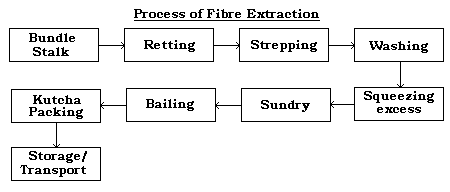|
|
About Jute
|
|
|
Jute cultivation
|
Jute is a rainy season crop, sown
from March to May according to rainfall and type of land. It is
harvested from June to September depending upon whether the sowings are early
or late.
|
|
|
|
Climate
and Soils
Jute requires a warm and humid climate with
temperature between 24° C to 37° C.
Constant rain or water-logging is harmful. The new gray alluvial soil
of good depth, receiving salt from annual floods, is best for jute. Flow ever
jute is grown widely in sandy loams and clay loams.
|
|
Sowing
of jute
Sowing of jute in midlands and high lands starts with
showers in March or April and continues till early June in the western part
of the jute belt. Compost or firm yard manure, Phosphorus and Potash,
Nitrogen fertilizers are used as a fertilizer. Interculturing is
essential in the early stage. Pasts are also require for plant
protection.
|

|
Introduction
|

|
Statistics
|

|
Cultivation
|

|
Gradation
|
 |
Manufacturing
|
|

|
Basic
Products |
 |
Testing
|
| |
|
| |
|
| |
|
Harvesting
Jute is harvested any time between 120 days to 150 days when
the flowers have been shed, early harvesting gives good healthy
fibers. The plant from 8 to 12 feet high are cut with stickles
at or close the ground level. In flooded land, plants are up
rooted. The harvested plants are left in field for 3 days for the
leaves to shed.
The stems are then made up into bundles for steeping in water.
Steeping is carried out immediately after harvest.
|
|
|
| |
|
| |
|
| |
|
| |
|
|
|
|
The
Fibre Extraction
The jute plant's fibres lie beneath the bark and
surrounded the woody central part of the stem. To extract the
fibres from the stem, the process is carried out in the following
stages :
|
|

|
| |
|
Retting
Retting is a process in which the tied bundles of jute
stalks are taken to the tank by which fibres get loosened and separated
from the woody stalk. The bundles are steeped in water at least 60 cm
to 100 cm depth. The retting process is completed in 8 to 30 days,
when the barks separate out easily from the stick or wood and the fibres are
ready for extraction. A development in recent years is adoption of
ribbon retting technology in jute growing trade of the country.
Stripping (Fibre Extraction)
Stripping is the process of removing the
fibres from the stalk after the completion of retting. Fibres are
removed from the stalk by any one of the following
methods :
(i) Single plants are taken and their fibers are taken off.
(ii) Taken off a
handful of stalks,breaking it in a to and fro motion in water.
(iii) Washing the stalks first by standing in waist deep water and
then stripping afterwards.
|
| |
|
When there is a plenty of water, bundles of stalks are laid in the pond ditches
or slow moving streams and left for 5-15 days under water. The
bunch of stem is held in one hand and the root end tapped lightly with a
mallet. After loosens the rest of fibres, fibres are extracted and
washed. |
|
|
Washing and Drying
Extracted fibres are washed in clean water. The
dark colour of fibres can be removed by dipping them in tamarind water for
15 to 20 minutes and again washed in clean water. After squeezing
excess water the fibres are hang on bamboo railing for sun drying for 2-3
days.
|
| |
|
|
|
Bailing
and Packing
The jute fibre is graded into tops, middles, B, C and X-bottoms.
Packing into Kutcha bales about 250 pounds for use in the home trade.
they are transported to jute market or direct to jute mills.
|
|

